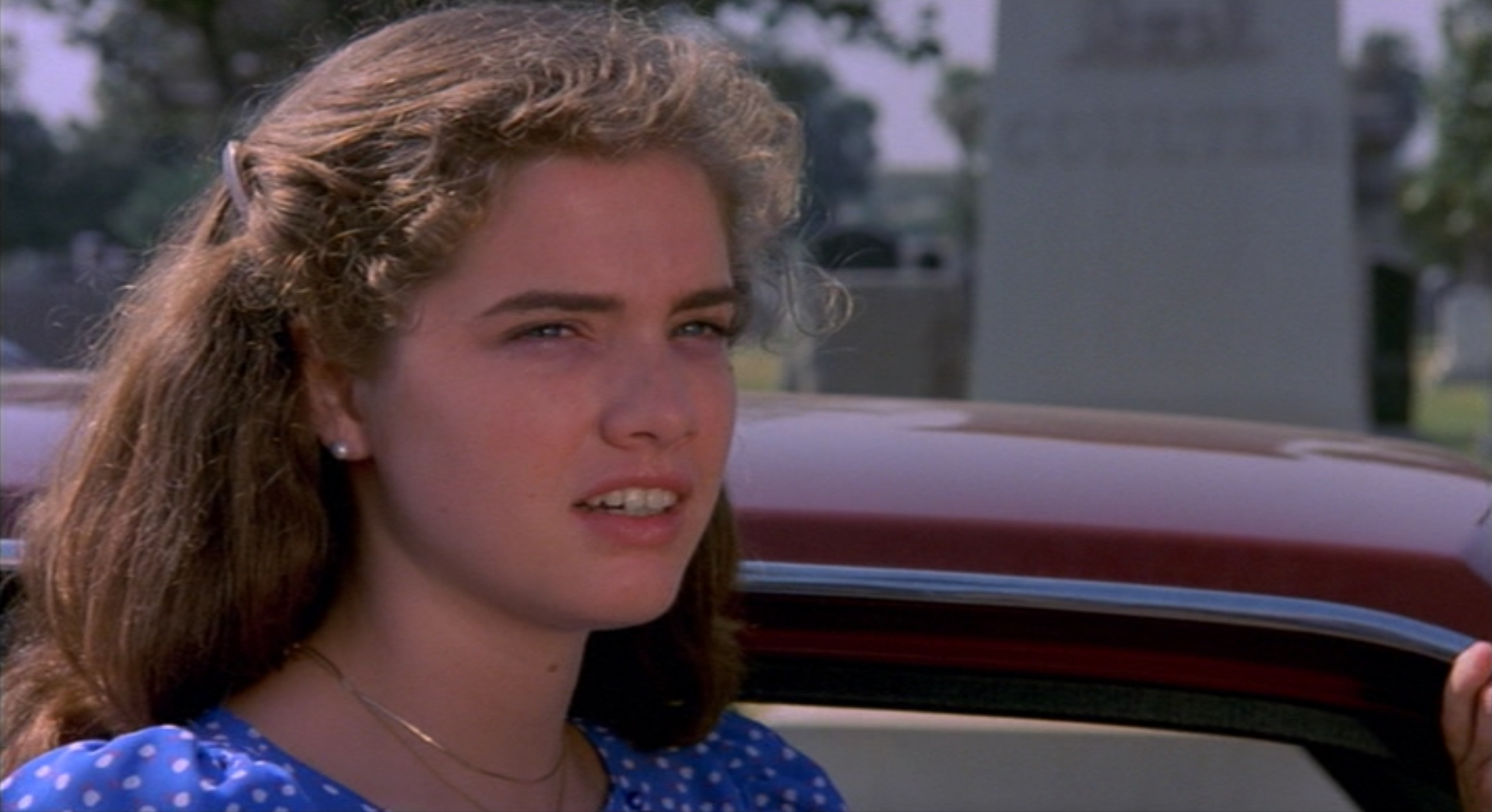When the late Wes Craven’s genre-shattering A Nightmare on Elm Street was released forty years ago, moviegoers were unfazed by the mental shift from trick-or-treating and candy corn to Black Friday and turkey that the stroke of midnight on November 1st typically dictates.
According to the film's consummate making-of companion book, Thommy Hutson's Never Sleep Again: The Elm Street Legacy, the low-budget, independent horror film made an impressive $1,271,000 in its first weekend in limited release. Opening wider the following week, on November 16, 1984, A Nightmare on Elm Street became one of the top ten movies playing across the country, remaining in that company for the next two weeks.
A new type of boogeyman—a severely burned, back-from-the-dead serial killer of kids, who murdered you in real life while slaughtering you in your dreams—had invaded America’s nightmares for decades to come.
“Hollywood wasn’t really set up like it is now to have these tent-pole movies at the perfect time of year and thinking ahead that way,” says Heather Langenkamp, who played Nancy Thompson, the first—and fiercest— of the many sleep-deprived teens battling with Freddy Krueger, actor Robert Englund's, ultimate personification of psychological terror.
“Certainly, [New Line Cinema founder] Bob Shaye was just a little independent producer at the time,” she adds. “I don’t think he thought it was a Halloween movie. I think he just thought it was a horror movie. Halloween didn’t used to be as big of a deal as it is now, believe it or not.”
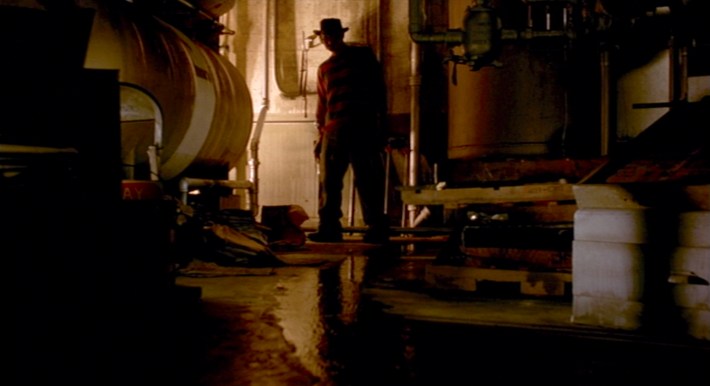
After three months, A Nightmare on Elm Street took in a final domestic box office gross of over $25 million on an estimated budget of $1,800,000 and saved New Line Cinema from closing up shop.
Certainly, A Nightmare on Elm Street’s success was mostly due to its modern and highly conceptualized vision of horror — and a fucking insane glove with knives for its extended fingers. But the film’s release was right on the heels of Ronald Reagan’s reelection, and presumably A Nightmare on Elm Street could have been taken as an antidote to Reagan’s “Morning in America” campaign that pitched a largely homogenized and sterile direction for the country.
The film is also, in part, an examination of the loss of youthful innocence in suburban America. As such, the film’s quaint settings of quiet, tree-lined streets, a collegiate gothic style high school, and a Main Street police station, are visuals that a broad swath of the country could relate to.
“I think Wes wanted it to be Anytown, America, and every town has an Elm Street,” says Langenkamp, quoting an iconic line from the sixth, partially 3D installment of the Elm Street series, Freddy’s Dead: The Final Nightmare (1991).
Craven, who passed away in 2015, had grown up in the Midwest.
“I think that was the kind of aesthetic that he had in mind for the small town vibe,” says Langenkamp.
Rachel Talalay, who was an assistant production manager and uncredited location manager on A Nightmare on Elm Street and would later go on to write and direct Freddy’s Dead, told me back in 2021: “I think Small Town, America, has some subtext of being a creepy place, but also the safest place the world.” (Talalay recently granted permission to reference her previously unpublished interview.)
The film's setting, formally introduced as Springwood in A Nightmare on Elm Street 2: Freddy’s Revenge (1985), was Ohio-inspired, according to Talalay. “It was just supposed to look like generically small town Ohio, and as far from an L.A. look as we could get. No palm trees,” she recalled.
With its untamed originality and earned longevity within popular culture, it’s no wonder that much has been made of film’s locations, all of which were shot in L.A. during the summer of 1984.
It’s fairly common knowledge among interested parties that the foreboding nightmare world of Freddy’s boiler room was shot at Lincoln Heights Jail.
But easily the film’s most frequented location is Nancy’s house. The Dutch Colonial style home, on Genesee Avenue in Hollywood, was built in 1919 and is known to attract Freddy fans from all over the world. Anytime the house goes on the market, you’ll be sure to find numerous articles written about it.
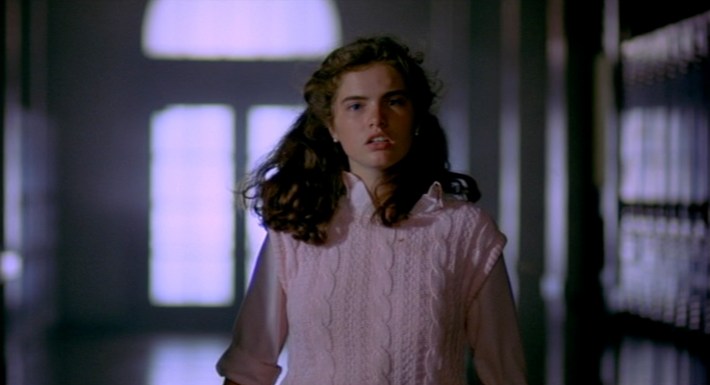
“The neighborhoods looked as Midwest or suburban as we could make them,” says Langenkamp, “but there are certain touches that I do think feel like California.”
In fact, some versions of the screenplay that can be found online clearly place the story in Los Angeles and the film includes bits of dialogue that are specific to the region.
Early in the movie, Nancy’s best friend Tina (Amanda Wyss) comments, after having a vivid nightmare, that perhaps an earthquake is on the horizon because “they say things get really weird just before.”
Some time after Tina’s abdomen is inexplicably sliced open and her body is violently thrown around her bedroom ceiling by an unseen force in front of her boyfriend Rod Lane (Jsu Garcia), a cop states, “[Tina’s] mother’s in Vegas with a boyfriend. We’re trying to reach her now.”
In other ways it feels like the film is just downright set in L.A.
Cars have California license plates. (In all fairness, however, a low budget film of this type may not have the personnel or bandwidth to go through and replace license plates on every car.)
A wide shot filmed in Venice shows Langenkamp and Johnny Depp, who plays Langenkamp’s boyfriend Glen, crossing a bridge over one of the canals. Large palm trees are clearly in view.
But it’s the iconographic L.A. imagery of Evergreen Cemetery that makes it the most paradoxical location in the film.
Palm trees that line the roads and punctuate the grounds of the cemetery are clearly visible in the film, glaring beneath the brilliant L.A. sunshine.
Talalay recalled that there were probably some angles to shoot in the cemetery that could have avoided the palm trees, but the main concern was just finding a cemetery that would let them shoot, period, especially a horror film.
“Nightmare was a tough script,” Talalay recalled. “It had sexual innuendo, it was pretty violent, it was very scary. There were religious touches to it as well. An alcoholic mother, a child molester.”
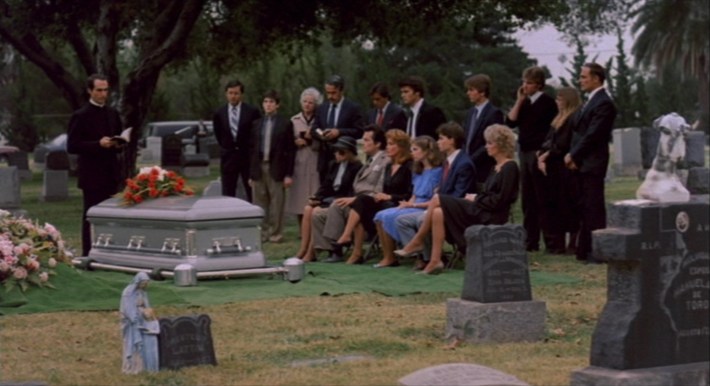
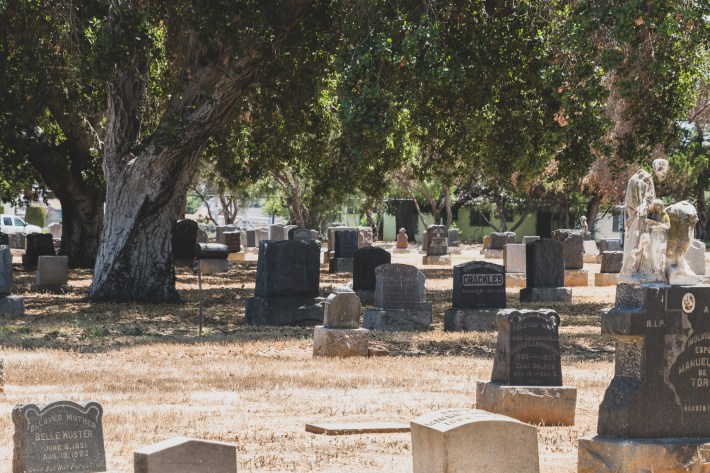
The sequence in question, however, is arguably the most poignant in the entire film. There’s no Freddy; there’s no spraying blood. Nancy is attending Rod’s funeral, the result of a nightmare in which Rod is hanged and killed in his jail cell after having been falsely accused of murdering Tina.
It’s also at the cemetery that we get our first indication that Nancy’s divorced parents, Marge (Renee Blakley) and Donald (John Saxon), know something about the guy that Nancy and her friends have been dreaming about, the one with the burned face, ragged hat, dirty red and green sweater, and razor-sharp digits. The entire sequence is less than two minutes long.
Langenkamp came to L.A. from Tulsa, Oklahoma. For roughly two years prior to being cast as Nancy at the age of 19, she worked on commercials, various movies of the week and after-school specials, and had starred in a film called Nickel Mountain (1984). She had never ventured into Boyle Heights before shooting the sequence in Evergreen Cemetery.
“I didn’t know Los Angeles that well when I moved here from Oklahoma,” says Langenkamp. “But as everybody knows, back then you had a Thomas Guide that you would literally hug to your chest when you were getting in your car, because it was the only way you could find places."
On the day of the cemetery shoot, Langenkamp got in her used Alfa Romeo, purchased for $500, and followed the directions provided by production, which took her from Silver Lake, past Downtown, and over to Soto Street.
“I remember driving early in the morning, in the dark, to get to the cemetery,” says Langenkamp. “I remember thinking to myself, 'I’ve never been over here, but I’ve heard that there’s really great tacos over here on Soto,'” says Langenkamp, laughing. “Robert Englund was such a foodie. He probably told me that the best food in town was over there.”
Established in 1877, Evergreen Cemetery is one of the oldest cemeteries in L.A. It is known for interments that reflect the Eastside's historically evolving, diverse identity. The cemetery also contains monuments for prominent L.A. families like Lankershim and Van Nuys.
“The thing that struck me most was how different it was from the cemeteries that I grew up around in Oklahoma and Washington, D.C.," says Langenkamp. "Just the vegetation and the palm trees, the brightness; it was so bright. The overall feel of it was just like a California cemetery.”
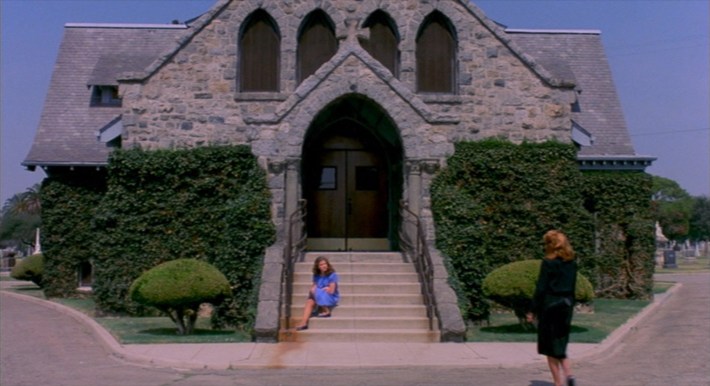
Langenkamp later mentions the stone chapel that is featured in one of the most minimalist, but thoughtfully composed shots in the film. After Rod’s funeral service concludes, Nancy sits alone on the steps of a gothic craftsman style chapel that was built in the 1890s. Set against the chapel’s oppressive gray stonework, Nancy stands out in her blue dress with small white polka dots, a conscious wardrobe decision, says Langenkamp, that juxtaposes Nancy’s innocence with the harsh realities she finds herself facing. Her mom approaches and they walk to the car where they meet up with Nancy’s dad.
Langenkamp says the chapel felt “Old World”, the type of building that can transport your mind to places in Europe where stone cottages were the norm.
“Thinking back to it, there’s just a sense of nostalgia and peace,” says Langenkamp.
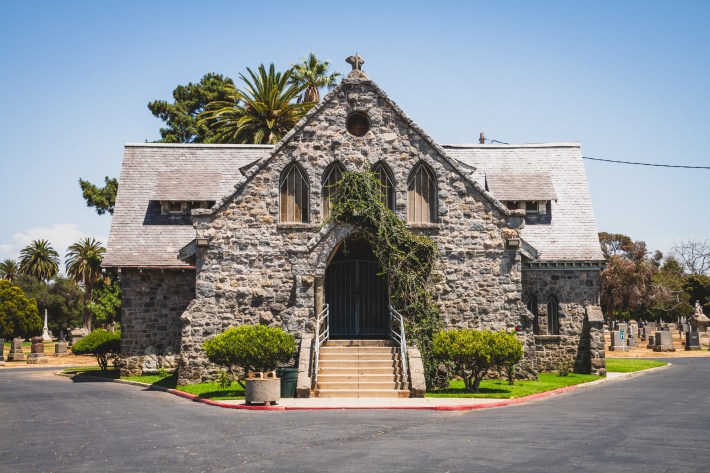
To the best of her recollection, Craven’s direction for the start of the scene in front of the chapel wasn’t terribly profound.
“He probably just said, ‘go sit over there.’ He was a man of little words,” says Langenkamp who worked with Craven a few times over her career, includingin the most meta of all Elm Street films, Wes Craven’s New Nightmare (1994), which was shot at the time of the 1994 Northridge earthquake. “Wes really relied on us to kind of figure it out.”
But upon watching the film, it’s clear that there’s a level of intellectual film-making going on that was perhaps void in other horror films of the era, and there was a lot more brewing inside of Craven’s head than he may have let on with his actors.
As Nancy describes the menacing figure that stalks her nightmares to her parents, Craven slowly zooms in on Donald’s face; Donald glances over at Marge; Craven cuts to Marge, who, with a concerned expression, looks at Nancy as the camera slowly zooms in on her. Nancy’s parents clearly know who she’s talking about.
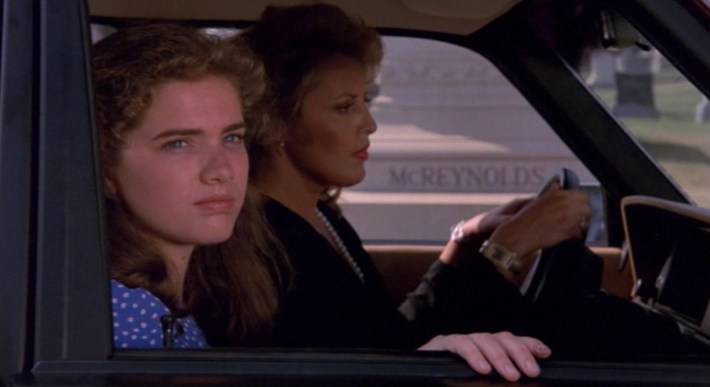
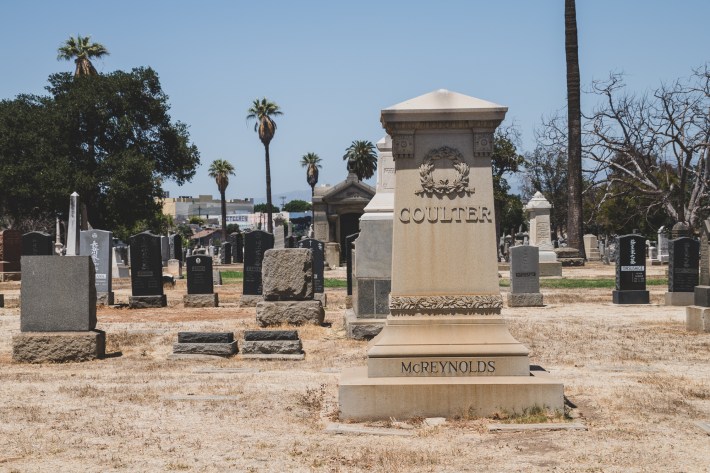
“The scene does a lot for the movie,” says Langenkamp, thinking back. “I never would have isolated it like this, but this location is just so neutral and it’s also so sad at its core. She’s already lost two of her friends, and her sitting on the steps, to me, just really represented the grief that a teenager would feel, or anybody would feel if they’d lost two friends in a week. And then you’re in this bright California sunshine. There aren’t that many opportunities to have sunshine in a horror movie, and so I think Wes really utilizes it to the best effect there."
“So maybe I’m just going to scratch everything I said before. It’s really obvious to me that this is a movie about California,” concludes Langenkamp with that same youthful laugh she has at the beginning of A Nightmare on Elm Street.
When asked if she’s been back to Evergreen Cemetery at some point over the last forty years, Langenkamp questions whether or not it was the Boyle Heights cemetery that appeared in some of the sequels.
“There’s the cemetery in Nightmare 3 where I’m wearing that crazy hat,” she says.
Indeed a few years after A Nightmare on Elm Street was released, the hit franchise returned to Evergreen Cemetery for the fan favorite installment A Nightmare on Elm Street 3: Dream Warriors (1987), in which Langenkamp co-starred. The chapel can be spotted in the background. The following year, the cemetery showed up again in A Nightmare on Elm Street 4: The Dream Master (1988).
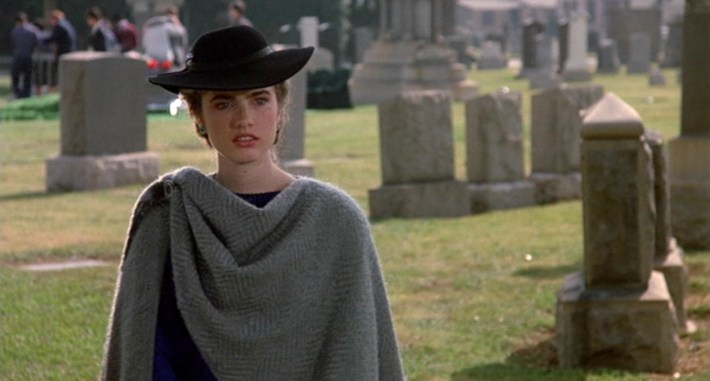
“In my mind, I feel like we shot there for New Nightmare,” says Langenkamp. “I feel like Wes would have wanted to do it there because the movie was trying to keep reflecting back on Nightmare 1.”
A Find a Grave search on a couple of the headstones seen in New Nightmare point to Angelus Rosedale Cemetery on Washington Boulevard in the Pico-Union neighborhood. The cemetery’s row of towering palm trees matches that which is glanced in the movie.

